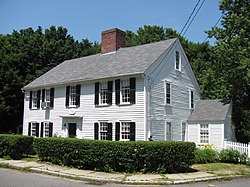
The Spencer–Peirce–Little Farm is a Colonial American farm located at 5 Little's Lane, Newbury, Massachusetts, United States, in the midst of 231 acres (93 ha) of open land bordering the Merrimack River and Plum Island Sound. The farmhouse, dating to c. 1690, was designated a National Historic Landmark in 1968 as an extremely rare 17th-century stone house in New England. It is now a nonprofit museum owned and operated by Historic New England and open to the public several days a week during the warmer months; an admission fee is charged for non Members.

The Nathaniel Topliff Allen Homestead is a historic house at 35 Webster Street in the village of West Newton, in Newton, Massachusetts. The Greek Revival house is notable as the home of Nathaniel Topliff Allen (1823–1903), an innovative educator in the mid-19th century. Allen's pioneering work influenced the development of new teaching methods taught at the state normal school. The house is listed in the National Register of Historic Places, and is currently owned by Newton Cultural Alliance.

The John Whipple House is a historic colonial house at 1 South Green in Ipswich, Massachusetts. Built in the seventeenth century, the house has been open to the public as a museum since 1899 and was the subject of some of the earliest attempts at the preservation of colonial houses. It was designated a National Historic Landmark in 1960, one of the earliest properties to receive that honor.

Academy Building is a historic building in Fall River, Massachusetts. The building was constructed in 1875 as a memorial to Nathaniel Briggs Borden by his family. It opened its doors on January 6, 1876. It was added to the National Register of Historic Places in 1973.

The Benjamin Stickney Cable Memorial Hospital is a historic hospital building at the junction of Massachusetts routes 1A and 133 in Ipswich, Massachusetts, U.S. The Colonial Revival building was built in 1917, following an extended fundraising effort, begun in 1906 and pushed further along by philanthropist and Castle Hill owner Richard T. Crane, Jr., after the 1915 death in a car accident of his friend, Benjamin Stickney Cable. Crane purchased the land on which the building sits and made a further donation of $145,000 to the construction fund.

The Dr. John Calef House is a historic house at 7 Poplar Street in Ipswich, Massachusetts. It is a well-preserved example of a First Period house with high-quality Georgian modifications. The core of the house was built c. 1671 by Deacon Thomas Knowlton, who purchased the land on which it originally stood on South Main Street in that year. It was subsequently altered in the middle of the 18th century, acquiring its present Georgian styling. In the 1770s the house was owned by noted Loyalist John Caleff. It was acquired in 1777 by John Heard, who moved the house to its present location in order to build a more elaborate Federalist house on the site.

The High Street Historic District is a predominantly residential historic district in Ipswich, Massachusetts. It encompasses the oldest section of High Street, which was laid out when Ipswich was founded in 1633. The district runs for four blocks from the junction with Town Farm Road and the railroad right-of-way in the west, to North Main Street in the east. The street was for several centuries part of the principal thoroughfare through the town, but became sidelined by the construction of Central Street in 1871, which bypassed traffic off most of this stretch of High Street.

The Ipswich Mills Historic District encompasses a major textile mill complex and associated worker housing along the Ipswich River near the center of Ipswich, Massachusetts. The district includes the factories of the Ipswich Mill Company, and several blocks of modest worker cottages mostly on side streets off Estes and Kimball Streets. The site had been used as for mills since the 17th century, and was purchased by the Ipswich Mill Company in 1868. Mill worker housing was built surrounding the complex through the early 20th century, when River Court, Peatfield Street, and 1st through 6th Streets were laid out. The district was listed on the National Register of Historic Places in 1996.

The Nathaniel Rust Mansion is a historic house at 83 County Street in Ipswich, Massachusetts. It is a 2+1⁄2-story colonial style house with First Period origins, indicated in part by its asymmetrical front facade. The date of its construction is uncertain; the first record of the house is its sale by Deacon William Goodhue to Nathaniel Rust, a tanner, in 1665. It was for many years located on the South Green, but was moved to its present location on County Street in 1837 by Asa Brown. Brown at the same time made modifications to the house, giving it its Federalist character. The house is one of the oldest houses in Ipswich that is situated outside one of its central historic districts.

The South Green Historic District encompasses one of the oldest central civic parts of Ipswich, Massachusetts. The town's South Green was laid out in 1686, and is now the heart of a collection of historic properties dating from the 17th to the 19th century. The centerpiece of the district is the green itself, and its most notable associated property is the John Whipple House, a National Historic Landmark and museum. The district boundaries extend from the junction of South Main and Elm Streets, southward past the green to where County Road crosses Saltonstall's Creek.
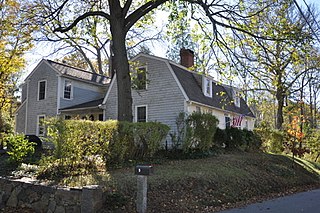
The Wade House is a historic house in Ipswich, Massachusetts. The 1+1⁄2-story gambrel-roofed central chimney house was built in 1792 by Francis Merrifield, Jr. It was acquired in 1827 by Mary Wade, daughter of local Revolutionary War soldier Nathaniel Wade. It has been in the Wade family since then. The house originally had two rooms downstairs and two upstairs; the rear of the house was added in two stages. A number of period details survive, including the central staircase and paneled doors. Fragments of period wallpaper have also been preserved, and reproduction wallpaper has been used in one of the downstairs rooms.
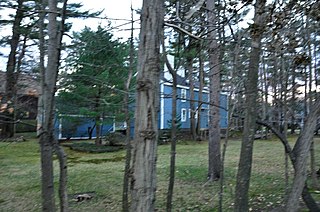
The Batchelder House is a historic house at 607 Pearl Street in Reading, Massachusetts. Built about 1783, it is a good local example of Federal period architecture. It is also significant for its association with the locally prominent Batchelder family, and as an early shoemaking site. The house was listed on the National Register of Historic Places in 1984.

The Capt. Nathaniel Parker Red House is a historic house at 77–83 Ash Street in Reading, Massachusetts. It is a 2+1⁄2-story vernacular Georgian house, five bays wide, with entrances on its north and south facades. The southern entry is slightly more elegant, with flanking pilasters and a transom window. The house was built sometime before 1755, and was already a well-known landmark because it was painted, and served as a tavern on the coach road. The Tavern served as a meeting place for many revolutionaries and minute men, notably Marquis de Lafayette, and Alexander Hamilton. The house remained in the hands of militia captain Nathaniel Parker and his descendants into the late 19th century. The construction of the Andover Turnpike in 1806–07, bypassing its location, prompted a decline in the tavern's business.

The Nathaniel Batchelder House is a historic house at 71 Franklin Street in Reading, Massachusetts. Built sometime between 1753 and 1765, it is a prominent local example of Georgian architecture. It is also significant for its association with several members of the locally prominent Batchelder family. It was listed on the National Register of Historic Places in 1984.
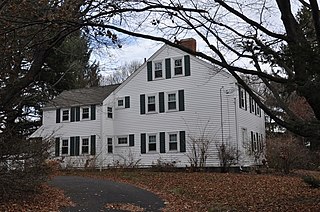
The Jonas Cowdry House is a historic house at 61 Prospect Street in Wakefield, Massachusetts. Built c. 1833, the Federal style wood-frame house is three bays wide and four deep, a significant local variant to conventional Federal style architecture. The house was listed on the National Register of Historic Places in 1989.

The Nathaniel Cowdry House is a historic house at 71 Prospect Street in Wakefield, Massachusetts. Built about 1764, it is one of Wakefield's oldest buildings, built by a member of the locally prominent Cowdry family, who were early settlers. The house was listed on the National Register of Historic Places in 1989.

This is a list of the National Register of Historic Places listings in Ipswich, Massachusetts.
Lakeman is a surname. Notable people with the surname include:
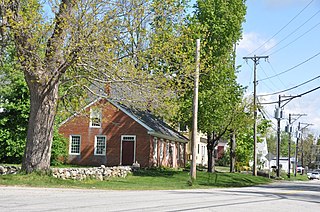
The New Ipswich Center Village Historic District encompasses the historic center of the rural town of New Ipswich, New Hampshire. The center village is the town's most densely populated area, with a history dating to the town's founding in 1735. The district extends along Turnpike Road between King and Porter Roads, and southward in a roughly triangular shape, the southern point of which is at the junction of Main Street and Willard Road. The village includes a large number of residences, which were mainly agricultural at first, but also include a number of properties built as summer resort houses in the late 19th and early 20th centuries. It also includes most of the town's historic civic buildings, including its historic town hall, and the Barrett House, now a museum property owned by Historic New England. The district was listed on the National Register of Historic Places in 1991.
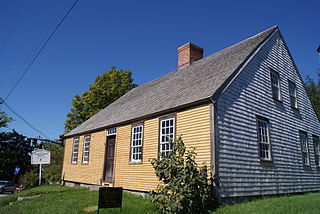
The Chapman-Hall House is a historic house museum at 270 Main Street in Damariscotta, Maine. Built in 1754 by one of the area's first permanent white settlers, it is the oldest standing house in the town, and one of the oldest in the state. It was listed on the National Register of Historic Places in 1970.
